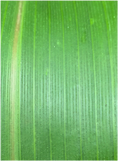 Corn leaves, as well with as other monocots, have multiple veins located parallel to each other within the leaves and ultimately connecting with vascular system of the stalk. They are critical to the distribution of the cell products and ultimately the grain. Structure and function of this system is summarized in Corn Journal blog of 5/17/2016. Corn leaf veins run parallel to each other to the length of the leaf. There are primary veins easily seen on each side of the leaf midrib and smaller secondary ones as seen in the photo. Basic function is to move water and minerals from the roots to the leaves and distribute photosynthesis products to other parts of the plant. It is complicated, of course. A single row of thin-walled cells surround the vascular bundle. These cells function to regulate and transform products into and from the other parts of the vein. In C4 plants like corn, special chloroplasts in the bundle cells perform the final stages of photosynthesis making sucrose and finally starch. At night the starch is broken down into smaller molecules, allowing it to move into the phloem components of the vascular bundle. Phloem tissue includes two cell types. Companion cells are the immediate recipients of materials from the bundle sheath cells. Chemical processes change the carbohydrates from the molecules as they arrive into forms that allows continual input. More changes allow the movement of sugars and proteins to be moved to the second cell component of the phloem tissue, the sieve cells. These living cells share cytoplasm with adjacent sieve cells above and below through pores, and thus allow the movement of carbohydrates to sink as dictated by plant hormones. The phloem thus becomes the means of moving carbohydrates from the leaf to meristem for more growth, to roots for growth and metabolism and to the grain. Phloem tissue is living, requiring energy to function. Death of phloem tissue stops translocation of carbohydrates. Phloem tissue also can be an avenue for viruses to spread through the sieve cell pores. The xylem portion of vascular bundles is composed of dead cells that function as a tube allowing water and minerals to move by capillary action from the roots to leaves and other parts of the plant. Water molecules consumed by photosynthesis or passing through stomata by evaporation (transpiration) are replaced because of the cohesion character of water. Fungal spores and bacteria can be moved through xylem cells as well, although xylem arrangements at the stem nodes can foil movements of larger particles such as these. Comments are closed.
|
About Corn JournalThe purpose of this blog is to share perspectives of the biology of corn, its seed and diseases in a mix of technical and not so technical terms with all who are interested in this major crop. With more technical references to any of the topics easily available on the web with a search of key words, the blog will rarely cite references but will attempt to be accurate. Comments are welcome but will be screened before publishing. Comments and questions directed to the author by emails are encouraged.
Archives
December 2021
Categories
|
 RSS Feed
RSS Feed